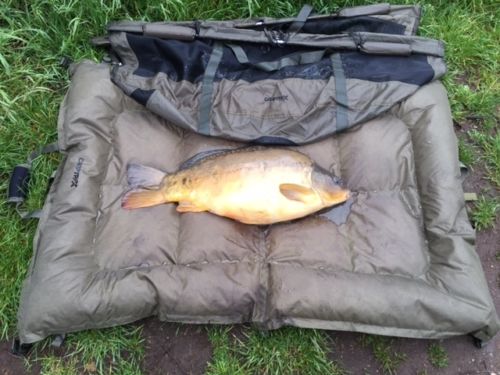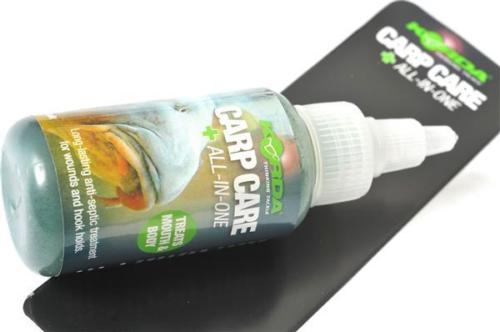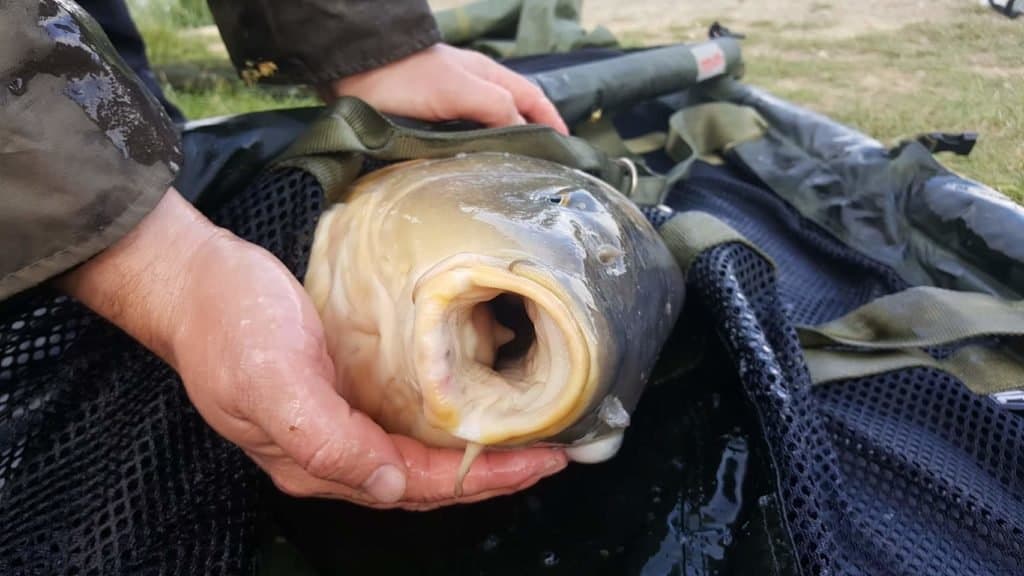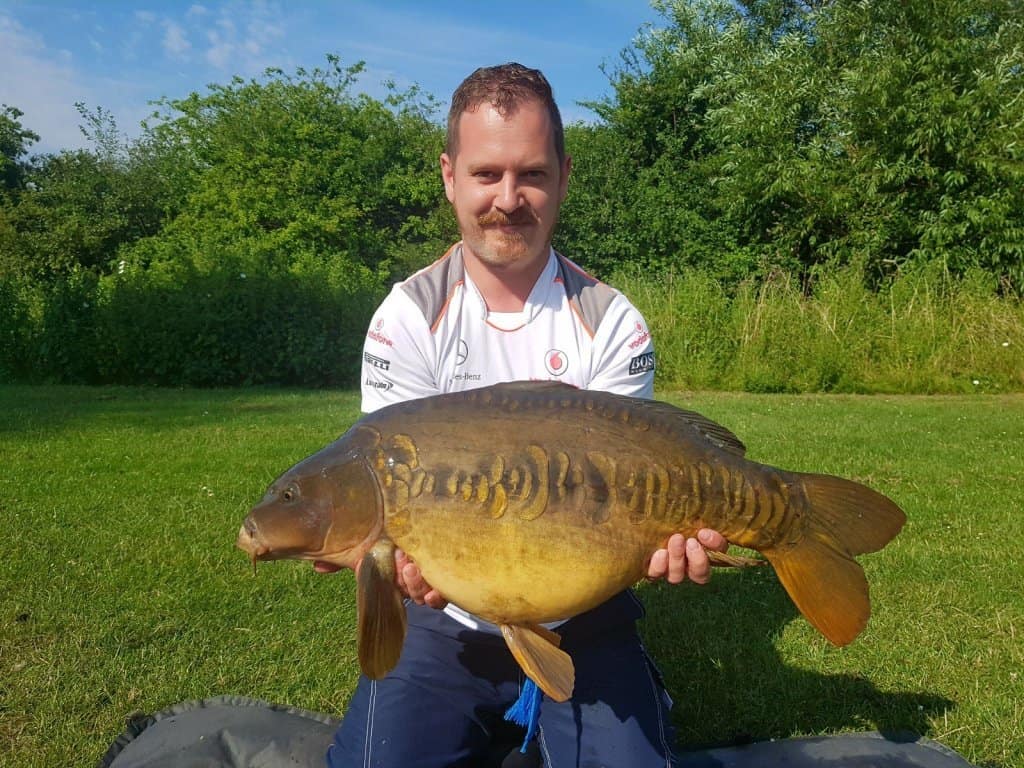Why Use a Carp Care Kit?
Every angler needs to take carp care seriously, and there is no excuse for not having a carp care kit in your tackle bag such as this one by Gardner Tackle.
Some carp care kits have two bottles in them, one for the mouth and one for the body. Other kits can be applied to all parts of the carp from one bottle, like the Garder Tackle kit linked above.
Korda also makes a fantastic little carp care kit that comes in a small zipped bag. It is basically a disinfectant for the fish. When you catch the carp, and before you take your picture, make sure you apply this liquid to any wounds, cuts or hook holes to help heal the wounds.
How to Use the Carp Care Kit
It is your responsibility to care for the fish that you’ve caught. So look it over, any damage from your hook or any other hooks in there? Make sure all the hooks are out and apply the liquid that says “Mouth” on the bottle. Then look around the outside of the fish, any scales missing? Is there any blood visible? If there is, apply the liquid that says “Body”. You should use cotton swabs for this, but your finger will do the trick in most cases – just squirt a bit on the swab or your finger and rub it onto the wound. It sounds simple but it’s really important.
The Carp Care Kit should always be part of your essential fishing equipment list.
A lot of fishery’s these days, will not let you fish without a carp care kit in your bag, so don’t get caught out and ruin your day for the sake of not having bought one.
It is essential that we future-proof the sport by protecting the fish we catch.
Minimising Damage to the Fish
Whilst some damage is caused by the fish swimming against sunken branches or by predatorial fish, most damage is caused by anglers not being careful enough with the fish when they are caught.
By having the right equipment, the potential for damage can be minimized. Along with being careful when handling the fish and experience, damage to the fish is dramatically reduced.
Below explains the minimum standards that should be considered to reduce the damage caused by anglers.
Fishing Net
Ideally, you should have a 42-inch fishing net (this is the best value net on Amazon) when fishing for carp, but as a minimum, it shouldn’t be any smaller than 36 inches such as this one. When fishing for specimen carp, the lake will likely have a “42-inch minimum” rule. The fishing net should ideally also have small holes. Net’s with larger holes can sometimes get caught on the fishes dorsal fin, particular with carp and can cause damage if they start wriggling whilst their fin is caught in the net. Ensure that your fishing net pole is of suitable length and strong.
Don’t lift the net out of the water by the handle, as the net handle will likely snap. Instead, use the handle to bring the net towards you and lift the fish out with the arms of the net. Best practice is to take the handle off of the net and wrap the net up so the fish is secure, but if you do this, make sure the fish’s fins are flat against the fish’s body or they could potentially snap.
As a side note, if there are catfish in the lake, you will need to have a 50-inch net (this is the one I have) set up nearby.
Unhooking Mat
If you are on runs waters fishing for single figure fish, a 24-inch unhooking mat will be sufficient, but as soon as there is a potential of catching specimen fish, you need to be using a 48-inch unhooking mat to make sure there is enough space to keep the fish safe if it starts flapping about on the mat. Always make sure the mat is wet before putting the fish on the mat. Be sure to check the temperature of the mat too if it has been sitting in the sun. Cool it down by floating it on the lake before putting the fish onto it.
Forceps
You should always have forceps in your tackle box even if you aren’t using barbed hooks. Carp use a sucking motion to eat food and have been known to such the hook deep into their mouths, making it difficult to get the hook out with fingers alone. There are all sorts of forceps, but these basic ones are more than sufficient.
General Carp Care
I have written a whole article about carp care here, but I will go over the basics while we are on the subject.
- Make sure you dip your nets as you enter the lake to mitigate the spread of disease between lakes.
- Don’t be too heavy-handed when reeling the fish in and playing the carp on your line, you will tear the mouth of the fish. Instead, set the drag of the reel correctly and let the fish tire itself out before netting the fish. Letting the fish tire will also minimize the amount it will flip on the mat.
- Pay off lots of line from the reel when the fish is in the net, there are times when you are holding the net and the rod when the rod may slip, pulling the line and in turn, pulling the hook whilst it is in the fish’s mouth.
- Find the deeper margin to net the fish, this will allow them to move about without catching themselves on the rocks and the branches in the shallow margins.
- Remove the net from the handle and roll the net up to transport the fish, this is a lot safer and more manageable.
- Remove any watches, rings or loose jewelry when handling the fish as they could lift a scale or wound the fish.
- When you remove the hook, make sure it is well out of the way so you don’t kneel on it and so the fish can’t get hooked again when flapping on the mat.
- Be sure to move the rod out of the way too as the rod tips are delicate and I have seen many be trod on when a fish has been caught.
- Be careful of the fishes’ scales when handling the fish as they are very delicate.
- Have a wet towel nearby, putting the wet towel over the fish’s eyes tend to calm them down when they are flapping around.
- If they do flap about, hold them firmly with your hands, do not lay on them as your clothes will remove the mucus from their body, which is there to protect them.
- Don’t carry carp for long distances in your hands or they could fall and cause serious damage.
- If possible, use a weighing sling with zippable sides so the fish can’t slide out of the sling.
- Don’t keep the fish out of the water for longer than necessary.
- Treat wounds and wet the fish before taking photos and weighing the fish.
- Don’t lift the fish up high, keep them low to the ground as much as possible.
- Ask your friends to help when possible so you can take care of the fish, they can prepare the weighing scales and wet the weighing sling whilst you are unhooking the fish.
- Allow the fish to rest in your weighing sling in the water and recover when putting it back in the water. When it recovers, it will swim away of its own accord.
Be gentle with the fish and treat them with care, even the smaller fish may one day be a world record and the damage you cause today could affect that fish forever. This has been noticeable on the smaller runs waters were young anglers tend to fish. A known issue is called parrot mouth, which is where the fish’s mouth gets damaged over and over, then when it heals, the mouth gets smaller and smaller.
Treat them with care, follow the steps above and keep the fish safe.
I have made a lot of mistakes during my fishing sessions and don’t want you to make the same mistakes. I’ve learned the hard way over 20 years of fishing most weekends, testing, tweaking, and testing again and now want to help you excel with your carp fishing.
If you need any help, you can reach me at Fishing Again’s Facebook page
Last Updated on February 5, 2024 by Shane














